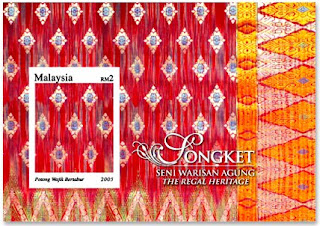 This series of stamps feature beautiful designs and motifs that can be found on a Malaysian brocade textile called Songket. Songket is produced by inserting gold or silver thread in between silk or cotton weft or latitudinal threads of the main cloth. Once exclusive to the Malay courts, songket is now accessible to anyone who can afford it. Prices range from above one hundred to tens of thousands of Ringgit per piece, depending on the workmanship and material.
This series of stamps feature beautiful designs and motifs that can be found on a Malaysian brocade textile called Songket. Songket is produced by inserting gold or silver thread in between silk or cotton weft or latitudinal threads of the main cloth. Once exclusive to the Malay courts, songket is now accessible to anyone who can afford it. Prices range from above one hundred to tens of thousands of Ringgit per piece, depending on the workmanship and material.The motifs featured are very much nature inspired, from local flowers, fruits and plants. The use of spatial harmony, balance, rhythm, repetition, and sizes of the motifs express a high level of artistic achievement. The golden or silver thread used in the songket adds rich elegance and glamour to the design of the fabric.
It is still popularly worn by the Malaysian for important occasions, ranging from traditional rites to official ceremonies
 and functions. Current efforts are in progress to promote and instill national pride in songket and to further propel it to global status.
and functions. Current efforts are in progress to promote and instill national pride in songket and to further propel it to global status.Pucuk Rebung Gigi Yu
Dubbed the bamboo shoot pattern, it has a very still, disciplined effect. Forming a wavy, indented edge like that of shark's teeth, it is one large, complex design of floral motifs. The overall effect is one of integration and harmony.
Bunga Bertabur Pecah Lapan
This scattered pattern of repeated motifs produces a beautifully harmonizing coverage, balance and visual beauty of the cloth. The flower motif has eight separated petals which meet in a distinct center.
Pucuk Rebung Gigi Yu dan Bunga Kayohan
 Another bamboo shoot inspired design formed with gold threads. Rows of flower motifs are intricately patterned in the center. This design is very popularly used for the "kepala" of the songket cloth. It is a very distinctly traditional and uniform pattern that lends a majestic feel to the fabric.
Another bamboo shoot inspired design formed with gold threads. Rows of flower motifs are intricately patterned in the center. This design is very popularly used for the "kepala" of the songket cloth. It is a very distinctly traditional and uniform pattern that lends a majestic feel to the fabric.Teluk Berantai Bunga Pecah Empat
This pattern can be woven in some ten distinguishable patterns. The solid chain (rantai) is woven in gold thread with floral motifs. The
 centers of the chain are filled with flower motifs with 4 separate petals to produce a softer, lace-like appearance.
centers of the chain are filled with flower motifs with 4 separate petals to produce a softer, lace-like appearance.Potong Wajik Bertabur
This simple scattered pattern creates great spatial coherence, balance and visual beauty with symmetrical motifs. This motif is inspired by the glutinous sweet rice cake called the potong wajik which is a popular Malay dessert.
 Technical Details
Technical DetailsDate of Issue : 29-Apr-2005
Stamp Value : 30 Sen; 50 Sen; RM 1.00 ( Setenant )
Stamp Size : 30 mm x 40 mm
Sheet Content : 20 Stamps
Miniature Sheet Denomination : RM2.00
Miniature Sheet Size : 100mm x 70mm
Stamp Size in Miniature Sheet : 30mm x 40mm
Perforation : 14
Paper : SPM Watermarked,Phosphor Coated
Printing Process : Lithography
Printer : Percetakan Keselamatan Nasional Sdn. Bhd.
Stamp Designer : TV3(Creative Services Dept.)
First Day Cover Value : 30 Sen
Presentation Pack Value : RM 4.50
Folder Value : RM 5.00











